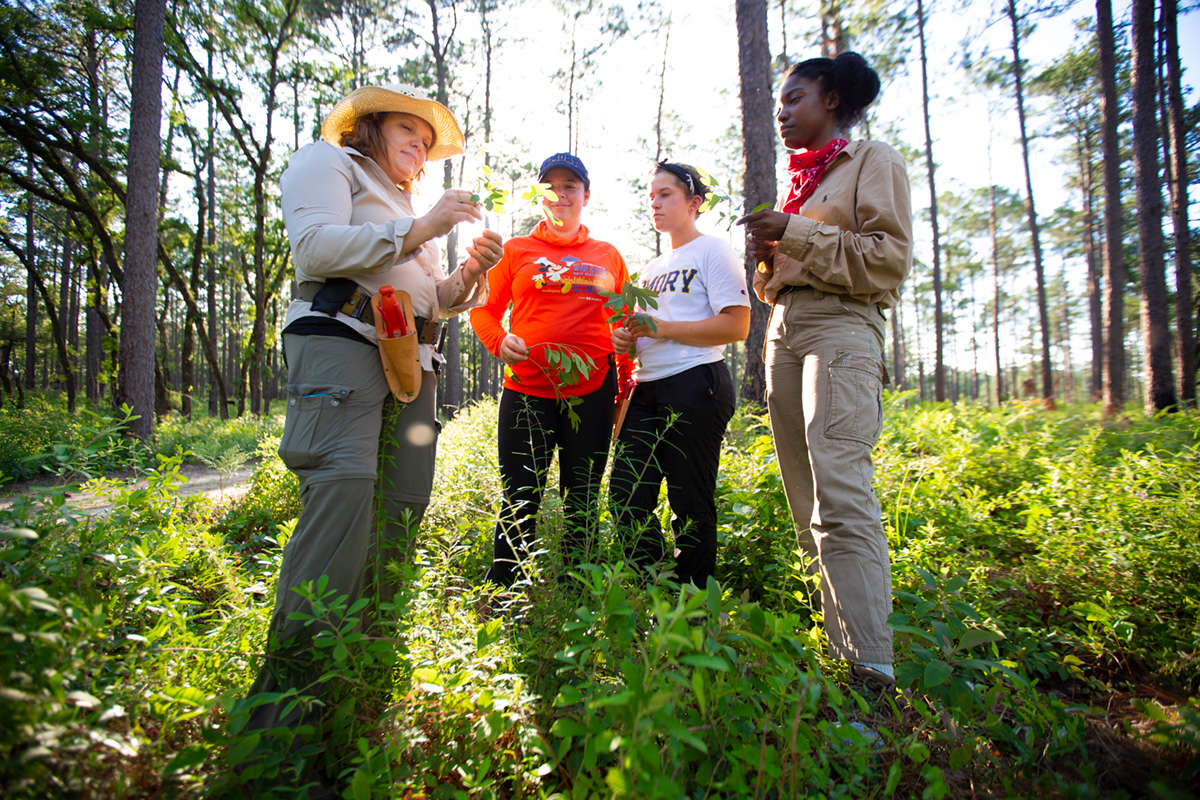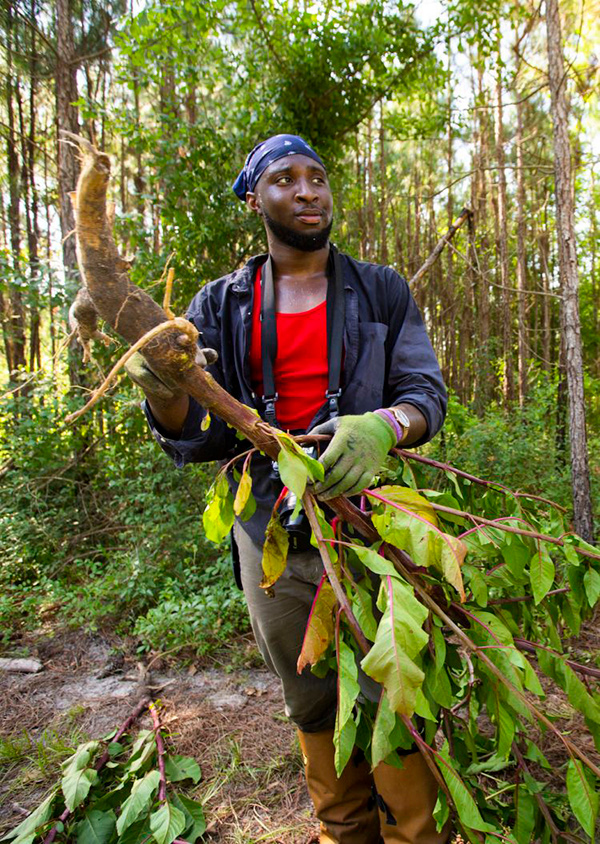The Plant Hunters
Ethnobotanist Cassandra Quave leads a search for the secrets of ancient remedies that may benefit modern medicine

Ann Watson
It’s a hot, muggy morning in a south Georgia longleaf pine forest, and sophomore Kathryn “Kat” Bagger 20C is snipping of stalks of wild passionflower with pruning shears. Dragonflies zigzag through spikes of maiden cane edging a nearby pond. An alligator’s head rises from the water, eyes jutting out like two knots on a log.
“My great-great grandmother was Cherokee, and she didn’t have access to health care,” Bagger says, by way of explaining why she was eager to spend part of her summer break in this remote forest known as Ichauway, home of the Joseph W. Jones Ecological Research Center.
Bagger is on a team of students who joined Emory ethnobotanist Cassandra Quave in the field to collect plants of medicinal importance to Native Americans. The Quave lab will extract the chemical compounds from the collected plants and test them for medical efficacy.
Bagger grew up in suburban Atlanta, but her Cherokee ancestor passed down some of her uses for herbs. She’s intrigued by questions surrounding Native American medicine: Which remedies work? Which ones don’t? Why?
“A lot of modern drugs come from plants,” Bagger says. “It’s important to learn what we can from traditional practices.”
Cassandra Quave (rhymes with “wave”) is an assistant professor in Emory’s Center for the Study of Human Health and in the School of Medicine’s Department of Dermatology, and a member of the Emory Antibiotic Resistance Center. The Florida native looks at home in the sweltering heat, standing behind a pickup truck parked on one of the dirt roads that winds through Ichauway. She tilts a straw cowboy hat back from her face and waves of a flurry of gnats. The unfolded gate of the truck bed serves as her desk, as she wrangles a leafy vine of passionflower into a wooden plant press.
“The Cherokee pounded the roots of passionflower into a poultice to draw out pus from wounds, boils, and abscesses,” Quave says. “Everywhere I look in this ecosystem I see plants that have a history of medicinal use by native peoples.”
While she was an Emory undergraduate herself, Quave did field research under the guidance of Larry Wilson, an ecologist in the Department of Environmental Sciences. She traveled to the Amazon to study the practices of Peruvian traditional healers—a life-changing experience.
She dropped her plan to go to medical school and pursued a PhD in biology, focused on medical ethnobotany. Today Quave is a world leader in the field, studying how indigenous people use plants in their healing practices, to uncover promising candidates for new drugs.
Tracking Down Ancient Medical Plants for Analysis
Among her recently published work: The discovery that the Brazilian peppertree—used for hundreds of years by Amazonian healers to treat skin infections—also contains an extract that can disarm antibiotic-resistant bacteria. The extract works not by killing the bacteria, but by blocking its ability to produce toxins.
“Using traditional plant remedies as an exploratory tool, we’re getting closer and closer to finding new ways to address major medical problems,” Quave says.
A copy of the research team’s goals for the three-week Ichauway trip rests on the truck’s tailgate: A list of around two hundred species of plants to collect and process for study. They are among the species that local Native Americans used to treat sores, nonhealing wounds, burns, and infections of the skin and soft tissues. The list was drawn from the work of other ethnobotanists, including Dan Moerman, at the University of Michigan.

Organic Approach: Emory senior Afam Maduka chose to major in human health because "it looks at health holistically."
Ann Watson
The name Ichauway is believed to have derived from a Muskogee word for “where the deer rest.” The 29,000-acre forest is four hours south of Atlanta in the southwest corner of the state, near the Florida border. Bob white quail, pocket gophers, red-cockaded woodpeckers, and gopher tortoises make their home here, along with more than a thousand native species of vascular plants.
In 1929, Robert W. Woodruff, the long-term chair of The Coca-Cola Company, established a quail hunting reserve on the property. In 1991, the Woodruff Foundation worked with other organizations to establish the Joseph W. Jones Research Center at Ichauway. The center hosts visiting scientists, develops educational programs, and conserves one of the last remnants of the unique longleaf pine ecosystem that once dominated the southeastern United States.
The Woodruff Foundation and The Coca-Cola Company supported the bulk of Quave’s summer fieldwork. Emory’s Summer Undergraduate Research Experience program (SURE) funded two of the students, while Bagger received the Garden Club of America Zeller Summer Scholarship in Medicinal Botany.
In the summer, Ichauway is a verdant cauldron swirling with insects and studded with thorns, brambles, and the occasional snake.
x“It’s like being a kid again, when my parents would let me run around and explore. You never know what you’re going to discover,” says Afam Maduka 19C, who grew up in a north Atlanta suburb.
The team members wear long pants and sturdy shoes. Heavy canvas gaiters wrap around their calves and shins to protect against snakebite. Occasionally they pull up the bandanas tied around their necks to cover their lower faces, bandit-style, and keep South Georgia’s relentless gnats from flying into their mouths and up their nostrils.
Maduka, who plans to become an orthopedic surgeon, is majoring in human health. “I like it because it doesn’t just focus on diseases and disorders,” he says. “It looks at health holistically by covering subjects like nutrition.”

Plant Parts: The collected specimens must First be broken down into different components. "Each leaf is like a chemical library," Quave says.
Ann Watson
When the truck bed fills up with bushel-sized cloth bags of plants, the team boards a van and heads back to the Jones Research Center to process the material. The dissected pieces of the plants are put into dryers—wooden cabinets containing shelves and dehumidifiers. Once the specimens are dried, Bagger and Maduka, decked out in protective goggles, gloves, and lab coats, load the material into a grinder. The machine shrieks and growls as it gobbles up pieces of plants fed down a metal funnel.
Bagger, who plans a career in psychiatry, chose to major in human health because she relishes experiences like this. “Everything is interconnected,” she says. “The more we can look at the whole picture, the better. You can’t have good health without balance.”
Research scientist James Lyles is Quave’s right hand, helping in the field, collaborating in her research, and managing her Emory labs. He recognizes that her work is special.
“There aren’t many medical ethnobotanists involved in the whole process,” he says, “from the field to chemical extraction and testing for efficacy against pathogens.”


